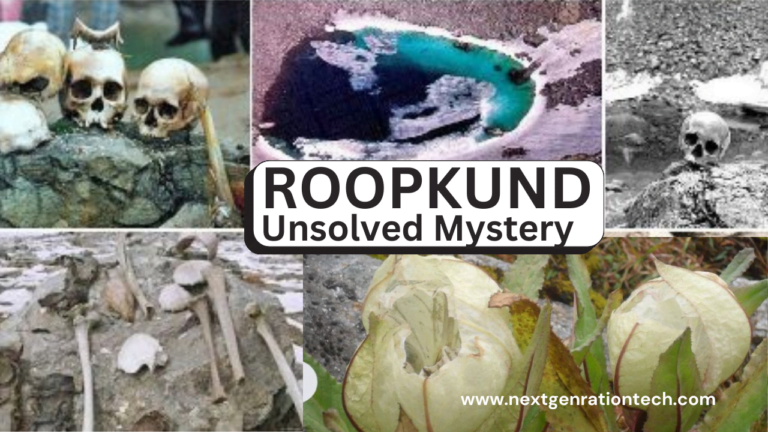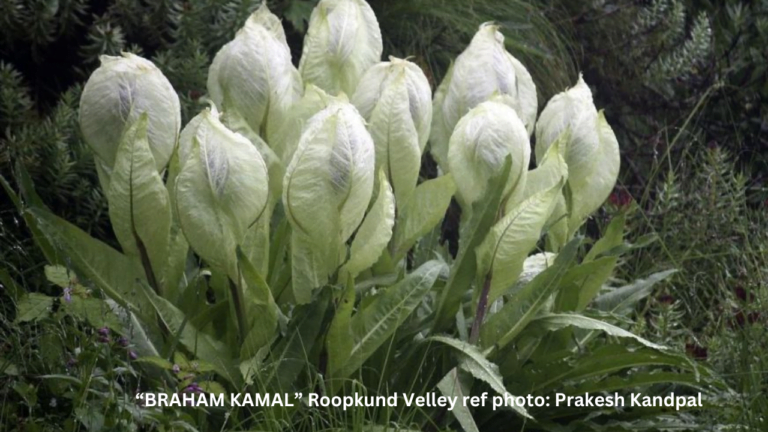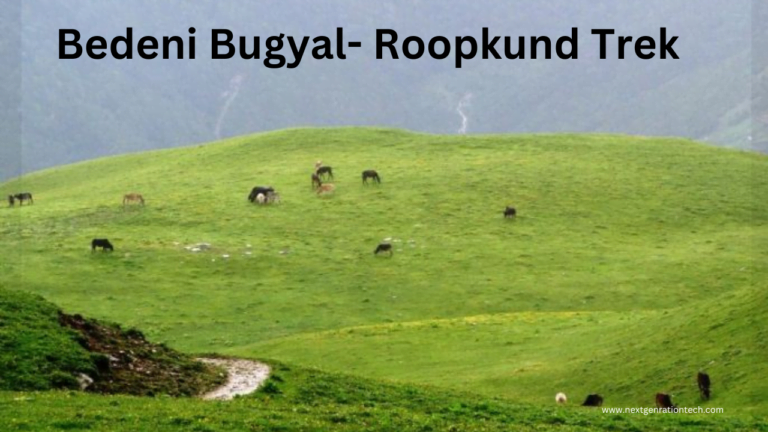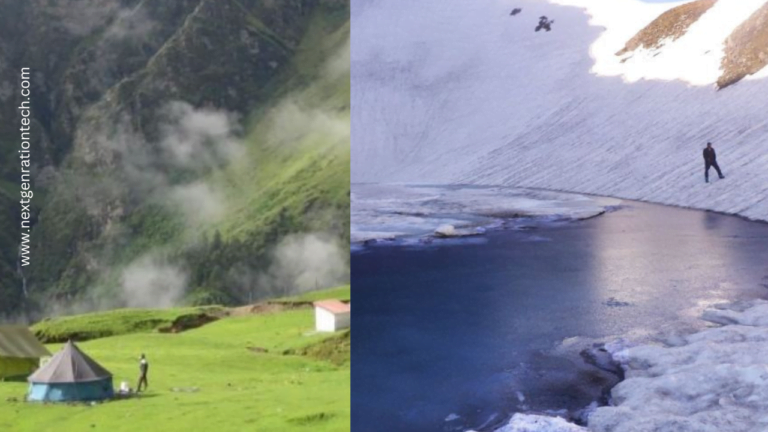Roopkund Best Time to Visit: Unlocking the Mystery for Thrilling Adventures
In this blog Roopkund Best Time to Visit. Immerse yourself in its intriguing past and ascertain the perfect moment to behold its breathtaking beauty.

Table of Contents
Introduction: Where is Roopkund Located?
In majestic Himalayas lies a place shrouded in mystery and adventure – Roopkund. This high-altitude glacial lake, is located in Chamoli district of Uttarakhand, India, has captured the fascination of trekkers, historians, and scientists alike.There are no long-term human settlements close to Roopkund, making it a remote place. Encircled by glaciers, it lies close to the foot of two peaks in the Himalayas, Trishul and Nanda Gunti. Despite its increasing popularity, its high altitude and constant snowfall make it uninhabitable for six months of the year.
Roopkund Temprature & Weather
Roopkund, situated in Uttarakhand, experiences cold temperatures year-round due to its high elevation. Summer (May-July) sees mild weather, with temperatures around 5-15°C during the day, dropping below freezing at night. Monsoon (late June-September) brings heavy rainfall, making trekking hazardous. Autumn (September-November) witnesses cooler temperatures, around 0-10°C during the day, and colder nights. Winter (December-February) is extremely cold, with temperatures as low as -5°C during the day and frequent snowfall. Visitors must prepare for varying conditions, especially cold weather and potential snow, ensuring appropriate clothing and gear for a safe trekking experience.
Roopkund: Unveiling the Secrets of the Skeleton Lake in the Himalayas
The entrance to a lake full of bones lies tucked away among the kind mountain tops. The surrounding of Roopkund Lake continues to draw attention. This place has been called “Mystery Lake” because it contains the bones of Paleolithic horses and human skeletons. For an extended period, archaeologists and scholars have been baffled by Roop kund Lake, which is situated in the Indian Himalayas at an elevation of over 5000 meters above sea level.
Imagine a lake encircled by bones. The damp air hangs heavily on your shoulders as you make your way across the mountains, encircled by a glacier scattered with rocks. It seems that long-dead spirits are watching you from every angle. This is the Roop kund Lake, a mysterious actual site in Uttarakhand, not some dream or haunted mansion.
A secret exists in the Indian Himalayas, renowned for its dangerous terrain & amazing beauty often known as “Skeleton Lake or Roopkund” where Hundreds of human skeletons are hidden along the frozen banks of these glacial deposits, Roopkund altitude is nearly 5,000 meters (16,400 feet). Scientists and explorers have been searching for the mystery surrounding them.
Understanding the Mystery-Why Roopkund is Known as Mystery lake? Roopkund Lake Mystery: A Glimpse into the Past
Roopkund Lake Mystery: A Glimpse into the Past
In 1942, hundreds of human remains were discovered stacked in and around Roop Kund Lake by an Indian forest official by the name of H K Madhwal. When the strange discovery was described —a hidden lake where 300–800 individuals perished tragically—the human remains were preserved by the cold Himalayas. When it was made public in the late 1950s, it sparked a lot of attention and led to various ongoing investigations.
Various realistic explanations were explained, such as an avalanche or a terrible pandemic, as well as fantastical ones like a lost army cursed by a local deity. But without hard proof, the Roopkund mystery remained unexplored for many years.

Skeletons in Roopkund Lake India: Who Were They?
Modern scientific advancements finally offered a glimmer of hope in unraveling the Roopkund mystery. DNA analysis of the skeletal remains revealed a surprising truth the skeletons belonged to not one, but three distinct groups.
One group appeared to be local to the region, possibly inhabiting the foothills of the Himalayas. The other two groups, however, presented a more intriguing puzzle. DNA analysis suggested these individuals originated from far-flung areas, possibly even the Mediterranean region. This unexpected discovery not only shed light on the origins of the people, but also hinted at a long history of travel and pilgrimage to this remote lake.
Roopkund Lake Scientific Discovery:
Roopkund Lake Scientific Discovery: Demystifying the Mystery
The discovery of diverse skeletal groups at Roopkund challenged the earlier theories of a localized event. Further scientific investigation, including radiocarbon dating, revealed that the skeletons belonged to two distinct periods. One group perished around the 8th century AD, while the other met their tragic end sometime between the 12th and 19th centuries AD.
The cause of death also remained an mystery. However, recent studies have offered a compelling explanation. Researchers theorize that these unfortunate individuals may have been victims of a sudden and violent hailstorm. At such high altitudes, even a short hailstorm can be deadly, catching unsuspecting pilgrims by surprise and leaving them exposed to the harsh elements.
While scientific advancements have shed light on the origins and possible cause of death of the Roopkund skeletons, some questions remain unanswered. What motivated individuals from far-flung regions to undertake such a perilous journey to this remote lake? Was Roop kund a sacred pilgrimage site for all three groups, or were they unfortunate travelers caught in the same deadly storm? These are questions that continue to intrigue researchers and fuel the enduring mystery of Roop kund.

Roopkund Best Time to Visit?
Lake Roopkund is inaccessible most of the year since the Himalayas have severe climatic conditions. As such, the best window for trekking towards Roop kund lies between late May to mid-June usually when the snow melts down uncovering the lake so that one could approach it without freezing to death. At this time, snow melts exposing the lake and giving a stable period of good weather.
However, within this time frame, there can be unpredictable weather changes. Be prepared for sudden changes in temperature, strong winds, or even snowfall. Therefore, packing the right clothing and gear is important to ensure a comfortable and safe trek.
Timing is crucial when planning a trip to Roop kund. Every season offers different experiences from beautiful blossoms to snow-draped environments.
Spring: Rebirth
In the vibrant colors of spring, Roop kund awakens from its winter slumber, adorned with blooming rhododendrons and lush greenery. The air is filled with the sweet fragrance of blossoms, and the landscape comes alive with a riot of colors, making it a paradise for nature lovers and photographers alike.
Summer: Excellent trekking conditions
During June-September Roop kund has clear skies with pleasant weather for trekkers. However, there may be some showers in July and August you should also be prepared for.
As summer unfolds, Roop kund transforms into an ideal destination for trekking enthusiasts. Clear skies and moderate temperatures create perfect conditions for exploring the rugged terrain and soaking in the panoramic views of the surrounding peaks and valleys.
Monsoon: A lush green paradise
With the onset of monsoon, when monsoon brings heavy rains over most parts of India Roop kund undergoes yet another transformation, as rain showers drench the landscape, turning it into a lush green paradise. Cascading waterfalls and mist-covered hillsides add to the allure, offering a unique and immersive experience for those willing to brave the elements.
Autumn: For photographers only
Between the months of September and November, Roop kund gets dressed in fantastic autumn hues. Golden trees and blue skies create amazing scenes for any photographer’s lens
The Snow Filled Adventure
Winter, for the most daring people on earth, is a challenging period of time that comes with great rewards. From December to February, Roop kund is draped in immaculate snow which provides an ideal atmosphere for trekkers. Winter blankets Roop kund in a pristine layer of snow, casting a magical spell over the landscape. Trekking through the snow-covered trails, surrounded by towering snow-capped peaks, is an adventure unlike any other, making it a dream destination for snow lovers and thrill-seekers.
You may also like:
(i)Rudraprayag to Kedarnath Distance Beyond the Numbers Discover the Wonder
(ii)Naina Devi Mandir Nainital नैना देवी मंदिर इस धार्मिक स्थल के पीछे की गुप्त बातें
(iii)Kainchi Dham Miracles Explored in 2024: Unraveling History, Location
(iv)Guptkashi: Unveiling the Sacred Gateway to the Himalayas

Plan Your Trip:
Before setting out on your journey to roopkund trek, do not forget to acquire relevant permits and consents from local authorities. Furthermore, they should research about available accommodation options in nearby villages or camping sites around.
Roopkund Trek Difficulty: Are You Ready for the Challenge?
The major challenge for Roopkund trek is due to high altitude and unpredictable climate conditions. It is important that people are physically fit for such heights because at these heights the air can be thin causing altitude sickness with symptoms like fatigue, headache and shortness of breath. Thus, trekkers need to get used by walking around in these heights before attempting such hike. Sudden snowstorms and hail are common hence proper equipment and experienced guides are necessary for a safe journey.
Depending on the beginning place and route chosen, the Roopkund trek’s length varies.The hike from the base camp at Lohajung usually takes 53 to 60 km (33 to 37 miles) total round trip.
The charm of the Roop kund hike goes beyond its haunting silence. The hike to the lake is a demanding physical test and offers amazing sights for adventure seekers. Usually, the trip begins at Govind Ghat hamlet, which is situated at an elevation of about 1,800 meters (5,900 feet). From there, trekkers set out on a multi-day adventure that takes them through glacial valleys, deep woods, and alpine meadows, gradually increasing in altitude with each day. At Roopkund, pilgrims gather for the once-every-twelve-year Nanda Devi Raj Jat, a festival dedicated to worshiping Goddess Nanda.
Why Roopkund Trek is Banned:
Ban on trekking in Uttarakhand that was never imposed.
In August 2018, the Uttarakhand High Court issued an injunction prohibiting overnight camping in bugyals or high altitude meadows due to the declining state of some trekking regions. They issued directives to erect permanent structures and restrict daily foot traffic from tourists to no more than 200. District magistrates were required to remove all plastic debris within six months, and commercial grazing was also prohibited.
They called it the ‘Roopkund Ban’.

Essential Tips for Trekking to Roopkund
- Physical Fitness: The Roopkund trek is physically demanding. Ensure you’re in good physical condition before embarking on this journey.
- Acclimatization: Altitude sickness is a real concern. Proper acclimatization at lower altitudes before attempting the trek is crucial.
- Gear and Clothing: Pack warm clothes, waterproof gear, sturdy hiking boots, and essential supplies like sunscreen, a first-aid kit, and water purification tablets.
- Guides and Permits: Hiring experienced guides familiar with the terrain and weather patterns is highly recommended. Don’t forget to obtain the necessary permits before starting your trek.
Safety Measuress & Precautions
Roopkund’s high altitude poses some risks such as altitude sickness. To have a safe trek, acclimatize well, hydrate properly and carry necessary trekking gears like warm clothes , rugged boots and first aid kits.
How to Reach Roopkund ?
Travel to Kathgodam:
Make your way from Kathgodam (Gateway to Kumaun) which is the closest major railway station to Roop kund. You may take a train directly from Delhi up to Kathgodam or you can use bus or taxi ride. (Alternatively one can start their journey from Haridwar (gate way to Garhwal)
Drive To Lohajung:
From Kathgodam you will either hire a taxi or board a bus going Lohajung, the starting point of Roop kund trek. The journey takes about 10-12 hours by road from Kathgodam to Lohajung village.
Initiate the Trek:
Once you reach Lohajung, get ready for Roop kund trek. Starting from Lohajung, the track will take you through attractive towns, deep forests and alpine grasslands.
Pass by Villages:
During your trekking journey, there are places like Didina, Bedni-Bugyal and Patar-Nachauni where you can experience local culture and hospitality.
Ascend to Roopkund:
You should continue climbing up with breathtaking views of Himalayan peaks ahead along the trekking trail. The landscape changes as you gain height until you reach the enigmatic lake of Roopkund.
Explore Roop kund:
Take some time to explore around Roop kund viewing the beauty of this lake surrounded by mountains.
Return Journey:
After enjoying yourself in Roop kund go back to Lohajung town via the way you used to come. From here head back to Kathgodam then Delhi thus terminating your trip.

Conclusion
In the mighty Himalayas, Roop Kund attracts tourists for its intriguing past and stunning natural beauty. Although it’s enigmatic past characterized by discovery of ancient human skeletons adds an element of mystery to it. However, it’s just a perfect surrounding that enchants all who visit this place.
Whether you’re drawn to the vibrant colors of spring, the lush greenery of monsoon, or the snow-covered tranquility of winter, Roopkund offers a perfect escape for every adventurer, promising unforgettable experiences amidst its mystical charm.
Frequently Asked Questions (FAQs):
Roopkund is renowned for its mysterious skeletal remains dating back to the 9th century CE, which have puzzled historians and scientists for decades.
While Roopkund trek is challenging, beginners can undertake it with proper preparation, guidance, and physical fitness.
There are no specific age restrictions, but trekkers should be in good health and physical condition to tackle the high altitude and rugged terrain.
Trekkers can find accommodation options in nearby villages like Lohajung, Wan, and Bedni Bugyal, or opt for camping at designated sites along the trekking route.
Basic medical facilities are available in some villages along the trekking route, but it’s advisable to carry a comprehensive first aid kit and any necessary medications.
This journey has a moderate difficulty level.
Depending on the weather, each trekker should allow an average of five to six hours for the trek. Nevertheless, a beginner with a basic level of physical fitness can safely complete this walk. The average hike to Roopkund lasts seven or eight days.
The skeletal remains of several hundred people of unknown provenance are dispersed over Roopkund Lake, which is located in the Himalayan Mountains at an elevation of over 5,000 meters above sea level. We present whole genome ancient DNA data for 38 skeletons from Roopkund Lake, revealing three separate groupings.
Roopkund Lake remains a fascinating enigma, drawing attention for its mysterious past. The discovery of human skeletons and even horses from the Palaeolithic period has earned it the intriguing nickname “Mystery Lake.” Situated at an altitude of over 5000 meters in the Indian Himalayas, Roopkund has puzzled archaeologists and researchers for decades.
The skeletons found in Roopkund are estimated to be from the Palaeolithic period, dating back several hundred (approx. 500-800)years. However, the exact age of the skeletons remains a subject of ongoing research and speculation among archaeologists and scientists.


Pingback: Uttarkashi The Kashi of North India in Uttarakhand
Your site visitors, especially me appreciate the time and effort you have spent to put this information together. Here is my website 57N for something more enlightening posts about Airport Transfer.